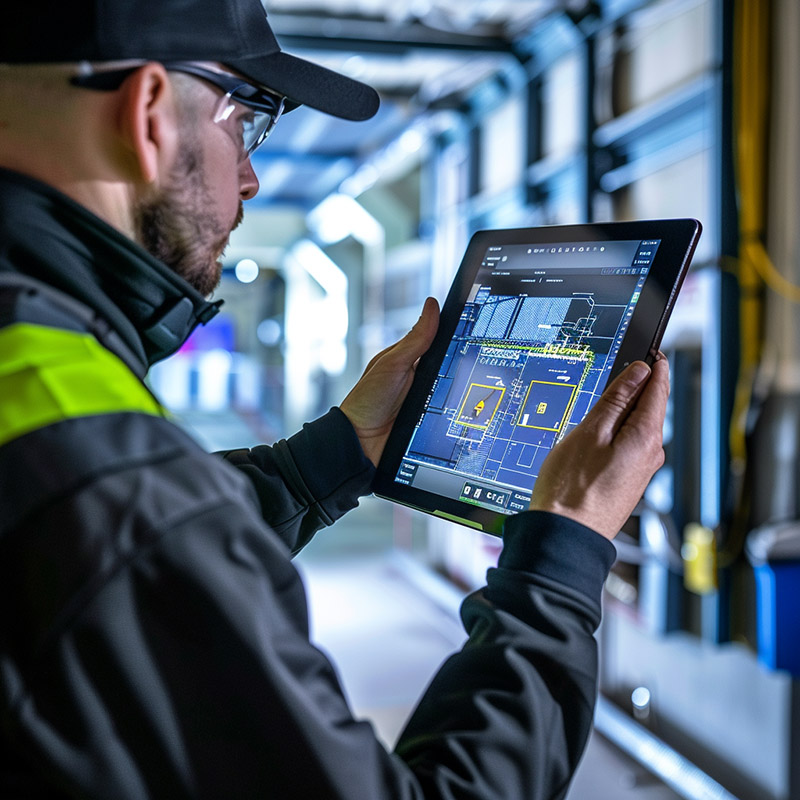1. Network Optimization
AI can analyze traffic patterns and automatically adjust network parameters in real-time to improve performance and bandwidth allocation, ensuring optimal data flow and reducing congestion.

Network Optimization Before AI
Network optimization often required manual intervention, with network administrators monitoring traffic and adjusting resources to manage congestion. This process was reactive, potentially leading to bottlenecks and suboptimal network performance during peak usage times.
Network Optimization After AI
AI-driven network optimization automatically analyzes traffic patterns and adjusts in real-time, preemptively rerouting data and balancing loads to prevent congestion. This proactive approach ensures optimal network performance, enhancing user experience by reducing latency and improving speed across all connected devices.
2. Predictive Maintenance
By monitoring network equipment health, AI can predict failures before they occur, scheduling preventative maintenance to avoid downtime and improve network reliability.

Predictive Maintenance Before AI
Predictive maintenance was challenging to implement, as it relied on scheduled checks or responding to failures as they happened. This often led to unexpected downtime and costly emergency repairs, disrupting services and operations.
Predictive Maintenance After AI
With AI, predictive maintenance has become a reality, enabling the early detection of potential failures before they occur. By continuously monitoring equipment health, AI algorithms can schedule maintenance efficiently, minimizing downtime and extending the lifespan of network components, resulting in cost savings and improved reliability.
3. Enhanced Security
AI algorithms can detect and respond to cybersecurity threats more efficiently than traditional methods, identifying unusual patterns that may indicate a security breach and initiating countermeasures instantly.

Cybersecurity Before AI
Cybersecurity efforts were largely reactive, with security teams responding to threats and breaches after they occurred. This approach left networks vulnerable to fast-moving attacks and sophisticated cyber threats, potentially compromising sensitive data.
Cybersecurity After AI
AI enhances cybersecurity by constantly analyzing network traffic for unusual patterns that may indicate a breach or attack. It can instantly initiate defensive actions, such as isolating affected parts of the network or blocking malicious activities, significantly improving response times and reducing the impact of cyber threats.
4. Intelligent Connectivity Management
AI can manage connections between devices and networks, seamlessly switching between Wi-Fi, LTE, 5G, and other wireless technologies to maintain the best possible connection based on user location, device capabilities, and network conditions.

Connectivity Management Before AI
Managing connectivity and ensuring stable wireless connections in areas with multiple overlapping networks often required manual switching and configuration, leading to interruptions and inconsistent service quality.
Connectivity Management After AI
AI revolutionizes connectivity management by seamlessly transitioning devices between networks (e.g., from Wi-Fi to cellular) based on signal strength, user location, and network congestion. This intelligent management ensures that users always have the best possible connection, enhancing the reliability and speed of wireless services.
5. Energy Efficiency
Through AI-driven optimization, wireless networks and devices can reduce power consumption by adapting transmission power and switching off idle components, contributing to longer battery life and lower energy costs.

Energy Efficiency Before AI
Wireless devices and networks did not optimize their energy use, often consuming power unnecessarily. This inefficiency led to higher operational costs and a greater environmental impact, with devices needing frequent recharging or replacement.
Energy Efficiency After AI
AI-driven solutions optimize energy consumption by adjusting signal strength, managing network traffic, and putting idle devices into low-power states. This not only extends battery life for devices but also reduces the overall energy footprint of wireless networks, contributing to sustainability goals.
6. Improved Signal Processing
AI can enhance signal processing techniques, reducing noise and interference in wireless communications, which leads to clearer calls and faster data transmission even in poor signal areas.

Signal Processing Before AI
Signal processing was limited by static algorithms, which could struggle with interference and weak signals, especially in crowded or remote areas. This often resulted in poor call quality and slow data speeds.
Signal Processing After AI
AI improves signal processing by dynamically adapting to interference and fluctuating signal conditions. It enhances call clarity and data transmission rates by intelligently filtering noise and boosting signal strength, providing a superior communication experience even in challenging environments.
7. Dynamic Spectrum Management
AI can dynamically allocate frequency spectrum based on demand and usage patterns, making more efficient use of available spectrum and supporting the growing number of wireless devices.

Spectrum Management Before AI
The static allocation of the frequency spectrum often led to inefficient use of this valuable resource, with some bands overcrowded while others were underutilized, limiting the potential for expanding wireless services.
Spectrum Management After AI
AI enables dynamic spectrum management, optimizing the use of the frequency spectrum based on real-time demand and usage patterns. This flexibility maximizes spectrum efficiency, supports more users and devices, and paves the way for new wireless technologies and services.
8. Automated Network Configuration and Deployment
AI can streamline the setup and deployment of wireless networks by automatically configuring devices and optimizing network layout based on environmental factors and user needs.

Wireless Network Configuration Before AI
Setting up and configuring wireless networks was a manual and time-intensive process, requiring expertise to ensure optimal coverage and performance. Mistakes in configuration could lead to security vulnerabilities or poor network performance.
Wireless Network Configuration After AI
AI streamlines network configuration and deployment by automatically recommending optimal settings and placements for network hardware. This reduces setup times, minimizes human error, and ensures that networks are secure and perform at their best from the outset, making wireless technology more accessible and reliable.
9. Quality of Service (QoS) Enhancements
AI can monitor network conditions and user demand to prioritize traffic and allocate resources, ensuring critical applications receive the bandwidth and latency profiles they require for optimal performance.

Quality of Service Management Before AI
Quality of Service management required manual prioritization of network traffic, often leading to suboptimal allocation of bandwidth among services and applications. This could degrade the performance of critical applications during periods of high demand.
Quality of Service Management After AI
AI dramatically enhances QoS by dynamically allocating bandwidth and prioritizing network traffic based on application needs and user demand. This ensures that critical applications, such as video conferencing or emergency services, receive the necessary resources for flawless operation, improving overall network efficiency and user satisfaction.
10. Fault Detection and Resolution
AI can rapidly identify and diagnose network issues, often resolving problems automatically or guiding human technicians to the source of the issue, reducing downtime and improving user experience.

Network Fault Detection Before AI
Detecting and resolving network faults often relied on user reports or routine checks, leading to delayed responses and prolonged service interruptions. Identifying the root cause of issues was a complex and slow process.
Network Fault Detection After AI
With AI, fault detection and resolution become instantaneous and precise. AI algorithms continuously monitor the network, instantly identifying and diagnosing issues, often resolving them automatically or guiding technicians directly to the problem source. This minimizes downtime and enhances the reliability of wireless services, ensuring a seamless experience for users.